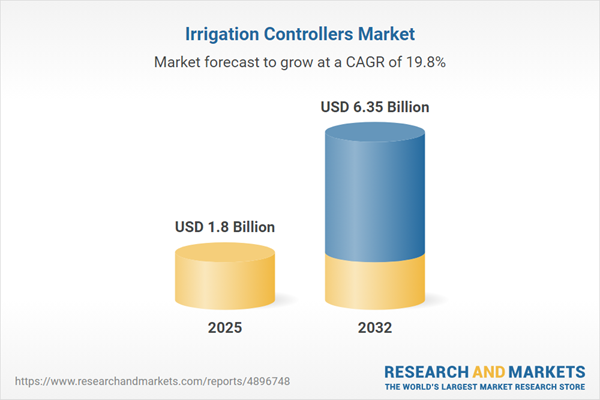Speak directly to the analyst to clarify any post sales queries you may have.
The irrigation controllers market is being transformed by rapid advances in digital technology and the growing demand for sustainable resource management. Senior decision-makers face evolving regulatory landscapes and are seeking agile, future-ready irrigation solutions to optimize water use while ensuring organizational resilience.
Irrigation Controllers Market Snapshot
The global irrigation controllers market is poised for significant expansion, underpinned by widespread adoption of precision agriculture practices, enhancement of digital infrastructure, and evolving facility management approaches. Strategic investments from both public and private sectors are accelerating improvements in water stewardship, operational efficiency, and compliance readiness. Industry providers are driving technological innovation, making it easier for organizations to integrate control systems with broader enterprise workflows. These developments are empowering a wide array of civil, industrial, and commercial operations to swiftly align with changing regulations. As a result, senior leaders are prioritizing tools that strengthen governance and optimize asset management in increasingly complex regulatory environments.
Scope & Segmentation of the Irrigation Controllers Market
- Connectivity Types: Bluetooth, cellular, Ethernet, and Wi-Fi support real-time monitoring and centralized irrigation management, enabling multi-site organizations to streamline oversight across diverse locations or compliance territories.
- Installation Types: Solutions are tailored for both new installations and retrofits, ensuring scalability as business needs evolve and enabling efficient integration with existing systems without complete overhauls.
- End Uses: Irrigation controllers deliver measurable value in agricultural, industrial, institutional, commercial, and residential settings—each with distinct operational complexities and regulatory standards shaping solution requirements.
- Geographic Regions: Adoption patterns across the Americas, EMEA, and Asia-Pacific are shaped by unique climate conditions, varying degrees of digital maturity, and region-specific regulatory frameworks, creating diverse opportunities and challenges for sector participants.
- Profiled Companies: Market leaders such as Rain Bird Corporation, Hunter Industries, The Toro Company, Netafim Ltd., Valmont Industries, Jain Irrigation Systems, Rivulis Irrigation, Orbit Irrigation Products, HydroPoint Data Systems, and Weathermatic are consistently refining product offerings to address evolving compliance mandates, sustainability objectives, and productivity goals.
Key Takeaways for Senior Decision-Makers
- Smart irrigation controllers help synchronize water management programs with shifting regulatory requirements and contribute to long-term sustainability strategies.
- AI-enabled and analytics-driven platforms improve operational visibility, streamline scheduling, and support compliance across distributed assets within organizations.
- Modular, open-system architectures enable staged upgrades, extending system longevity and protecting legacy investments as business demands change.
- Implementation strategies based on regional benchmarks and compliance targets foster operational efficiency regardless of the regulatory climate.
- Strengthening local supplier relationships and expanding domestic production capabilities reduces exposure to global trade disruptions and supports supply chain continuity.
Tariff Impact: Navigating Import Challenges
Recent changes in U.S. tariff policy are prompting irrigation controller manufacturers and suppliers to diversify sourcing strategies and enhance domestic production. This shift aids organizations in mitigating risks from trade uncertainties and logistical delays. By broadening supplier engagement and optimizing operational processes, businesses can maintain stability and agility when facing unexpected supply chain disruptions.
Irrigation Controllers Market: Technology and Adoption Trends
Smart irrigation controllers are reshaping water resource management across the sector. Increased utilization of artificial intelligence, machine learning, and cloud-based controls gives organizations better monitoring capacities and adaptability to variable operating conditions. Wireless connectivity offers a practical means of managing multiple locations and responding quickly to shifting local requirements, especially for compliance. Modular and upgradable systems extend the useful life of assets and support further digital transformation, helping drive responsible resource use and sustained infrastructure value in the face of evolving market expectations.
Methodology & Data Sources
This analysis draws directly from interviews with industry executives, facility operators, and system integration specialists. Information sources include patent reviews, peer-reviewed literature, and the latest regulatory content. Expert panel validation further ensures analytical rigor and practical relevance for procurement and strategy leaders.
Why This Report Matters
- Outlines practical deployment strategies tailored to diverse property and infrastructure requirements while ensuring regulatory compliance.
- Equips organizations with actionable perspectives for strategic capital allocation and system modernization, reducing compliance exposure and operational uncertainty.
- Translates dynamic market and regulatory trends into frameworks for resilient resource management and informed strategic planning.
Conclusion
Advanced irrigation controllers empower enterprises to meet adapting facility requirements and rising compliance demands. Leaders using these solutions can align organizational priorities with ongoing digital advances and sustained operational improvement.
Additional Product Information:
- Purchase of this report includes 1 year online access with quarterly updates.
- This report can be updated on request. Please contact our Customer Experience team using the Ask a Question widget on our website.
Table of Contents
3. Executive Summary
4. Market Overview
7. Cumulative Impact of Artificial Intelligence 2025
Companies Mentioned
The companies profiled in this Irrigation Controllers market report include:- Rain Bird Corporation
- Hunter Industries, LLC
- The Toro Company
- Netafim Ltd.
- Valmont Industries, Inc.
- Jain Irrigation Systems, Ltd.
- Rivulis Irrigation, Inc.
- Orbit Irrigation Products, LLC
- HydroPoint Data Systems, Inc.
- Weathermatic, LLC
Table Information
| Report Attribute | Details |
|---|---|
| No. of Pages | 193 |
| Published | October 2025 |
| Forecast Period | 2025 - 2032 |
| Estimated Market Value ( USD | $ 1.8 Billion |
| Forecasted Market Value ( USD | $ 6.35 Billion |
| Compound Annual Growth Rate | 19.7% |
| Regions Covered | Global |
| No. of Companies Mentioned | 11 |









